Today Athens is a large, bustling city with a population – suburbs included – of over three million. It has its own particular Greek flavor, of course, but it also has many common characteristics with other European capitals: a lot of traffic, pollution, the usual ubiquitous shops, restaurants, cafés, museums, opera houses, theatres, squares and parks.
Athens, however, is a relatively new city, which evolved, in the 19th century, from a regional town of the Ottoman Empire to the capital of the new Kingdom of Greece. After the liberation from the Turks, it was a ruined and semi-abandoned town. But King Otto, the young Bavarian prince sent over by the Allies, declared it a capital, and in 1834 its reconstruction began, under architects Stamatis Kleanthis, Edouard Shaunert and Leo von Klenze, the king’s counsel.
It was then that the neo-classical buildings which even now give the city distinction were erected, starting with the Royal Palace, which was paid for by King Otto’s father, the king of Bavaria, as a personal loan to his son. In 1934, after extensive renovation following two fires (the royal family had meanwhile moved to a new palace), the building became the House of Parliament.
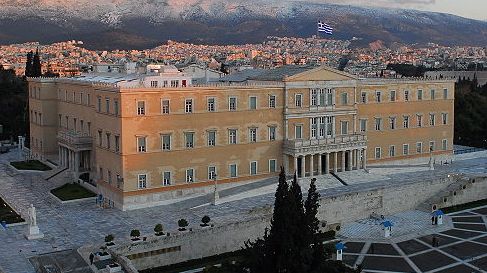
The University of Athens was designed by the Danish architect Hans Christian Hansen and built with financial support from the king, the king of Serbia and various prominent Greeks.

The Athens Cathedral was also initially designed by Hansen, but finished by Greek architect Dimitris Zezos, who added Byzantine aspects. The church was partly built using material from abandoned Byzantine churches.

There were many other public buildings built at that time, as well as private residences.
Fast forward to circa 1917, after the first war, when the following photos were taken by our French Allies.

Cattle at the temple of Hephaestus.

Cooking with a view of the Acropolis.
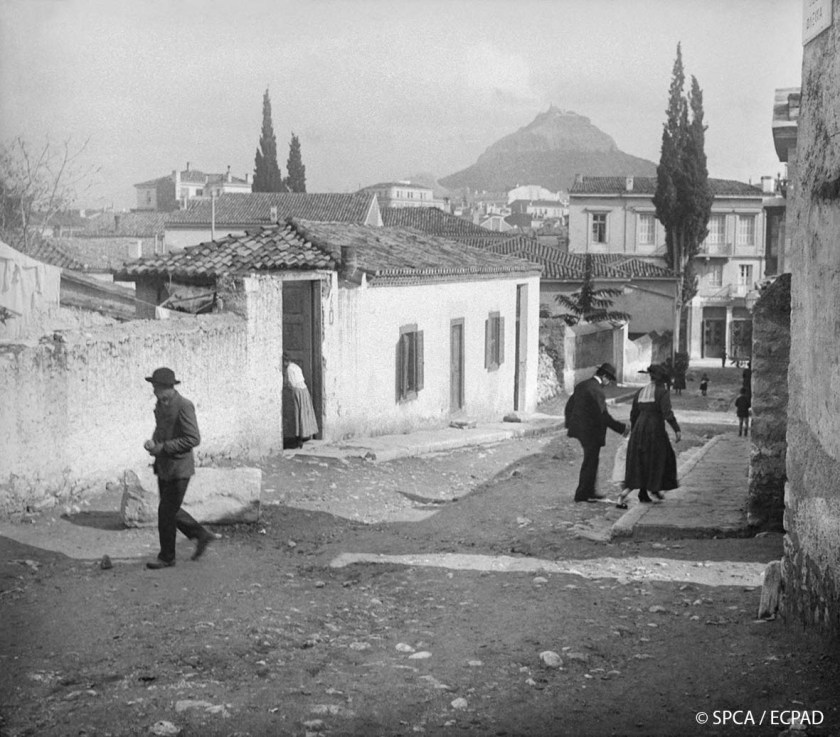
A neighborhood near the center.
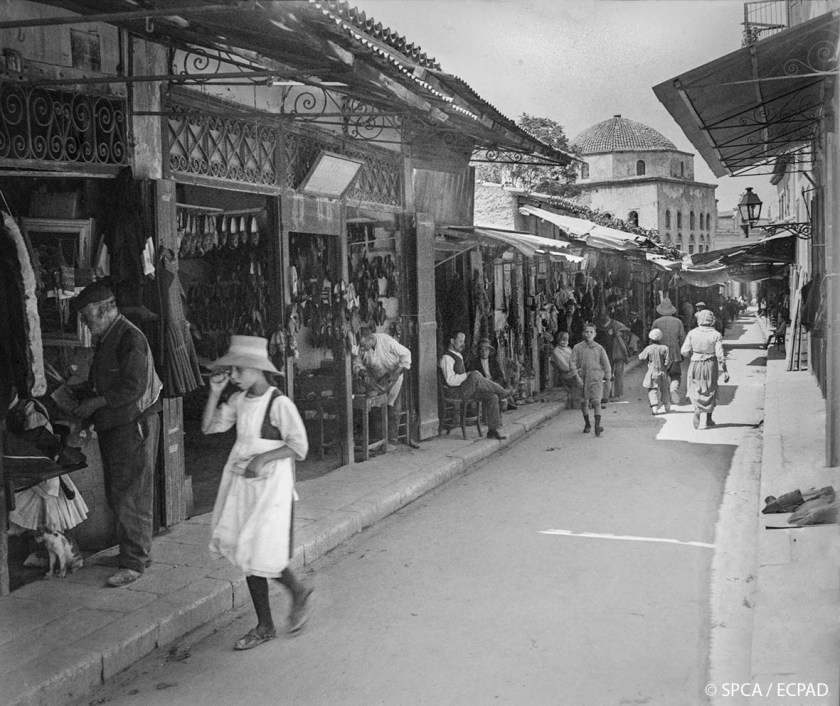
A shopping street with a mosque in the background.
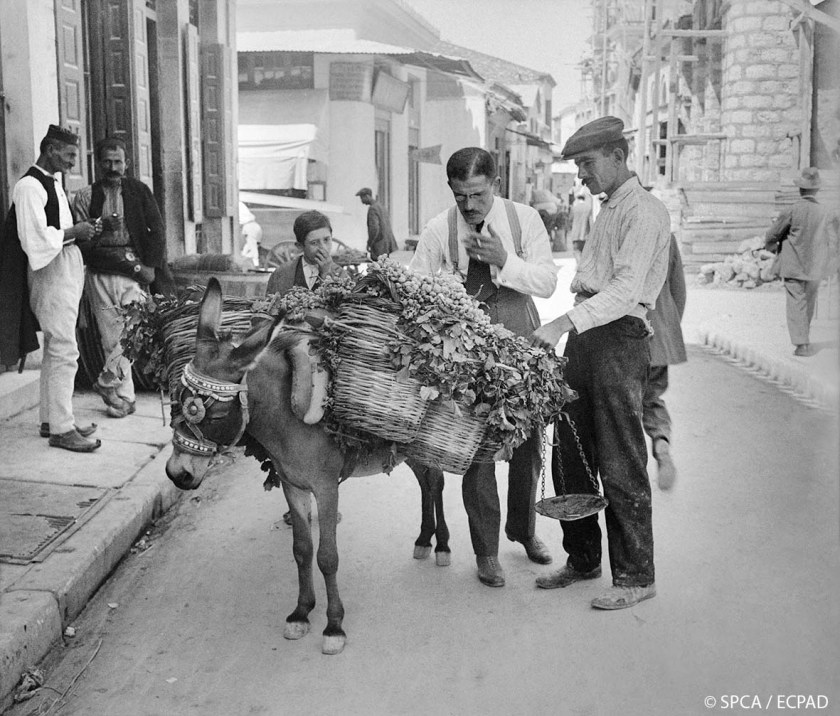
Buying grapes. Some men still wore traditional clothing.
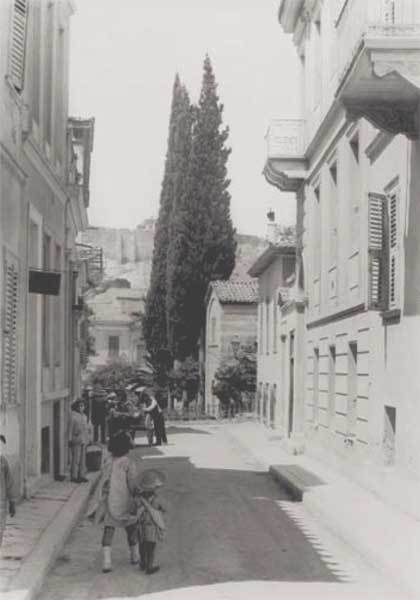
Children playing in the streets of Plaka, beneath the Acropolis.
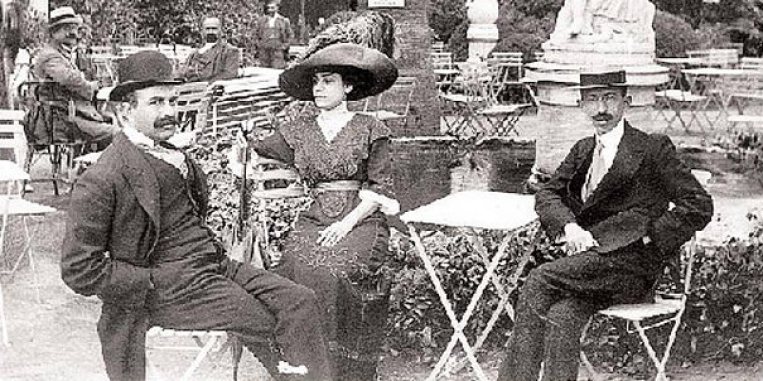
Coffee in the garden of Zappeion. In the early twentieth century, Athens was still a provincial town of circa 180.000 people.
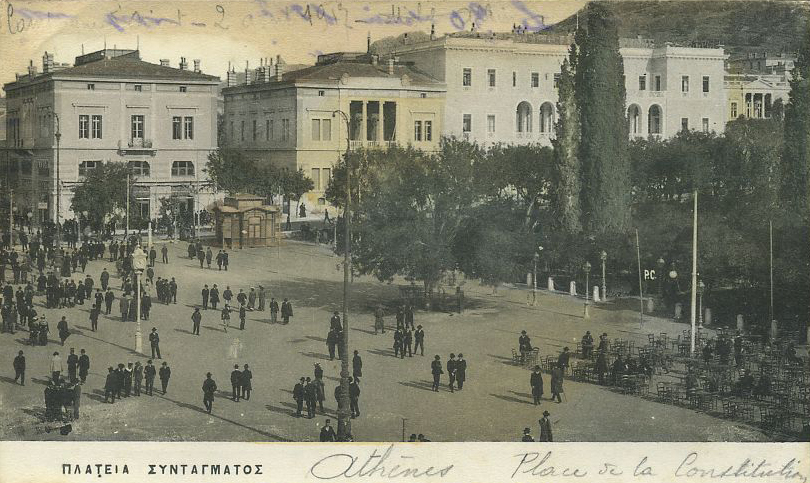
Constitution Square: The large white building on the right was built in 1842 and since 1874 houses the Grande Bretagne Hotel, where history has been written many times over and which is still today one of the great luxury hotels in the world. In 1888 it was one of the first buildings in Athens to have electricity installed.

One of the main commercial thoroughfares, Stadiou Avenue, in 1935.
During WWII, Athens came under German occupation.

The city suffered great destruction and famine, exacerbated by the civil war which exploded following liberation from the Germans, and which raged until 1949 (my parents always told us this was much worse than the German occupation).
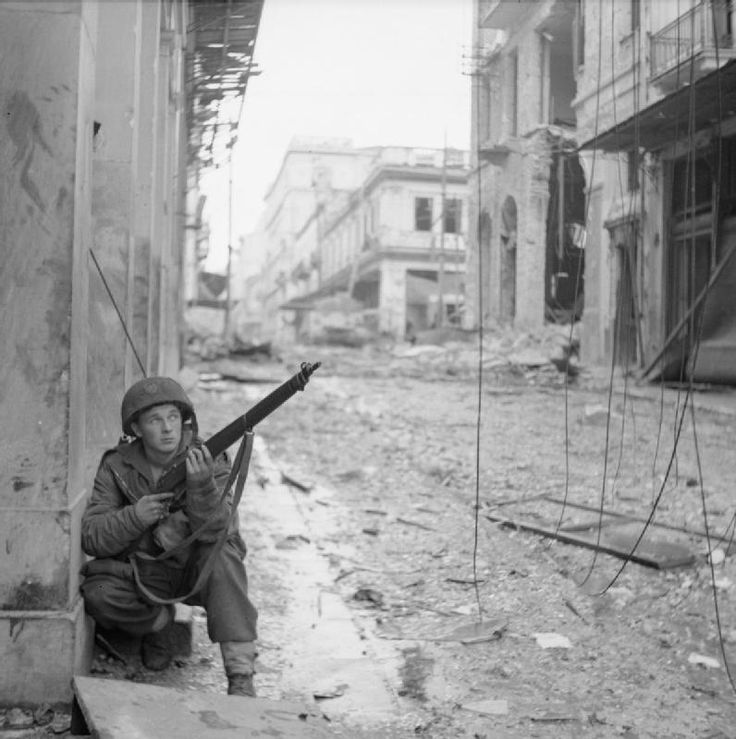
A British soldier in Athens during the civil war.
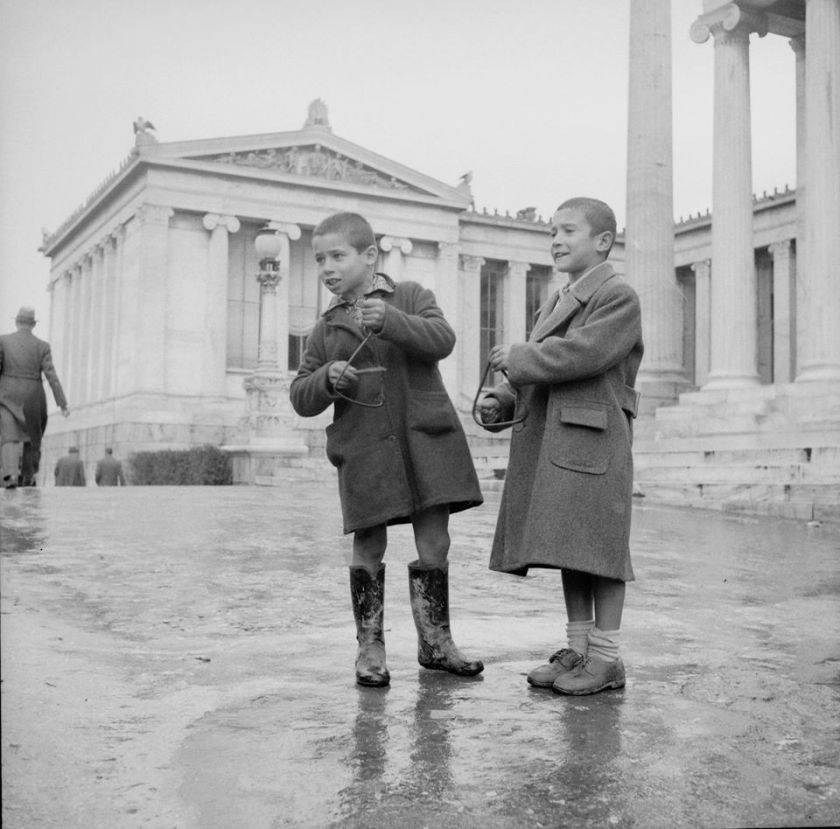
Children singing carols in the early 1950s. Ill-fitting coats, heads shaven against lice, but at least these two have shoes on.

The ice-cream man. Many years later, a man on a bike pushing an icebox still came into the park where we played when I was a child. I vividly remember our excitement, and the smell of the ice as the heavy lid was lifted, and we bent over the box to make our choice: vanilla or chocolate, on a stick or in a cup. It was a real treat.
This is far from pretending to be a comprehensive overview of the long and complicated history of Athens. I just happened upon these old pictures and thought they gave off a charming aroma of time passing.
Syntagma (Constitution Square) then…

And now…

All images are from Google. Since most are old, it was difficult to attribute credit.


This is fascinating – love all the old photos and the stories behind. I didn’t know all this about Athens and have confidence that it will rise again as a powerful and sound economic force and a symbol of enduring Greek culture and history.
LikeLike
That was fascinating. When I think of Athens it is either of the city in the time of the ancient Greeks, or as it is now. Now I have a better picture of it as a multilayered city. Those old photos are a glimpse into that time.
LikeLike
I love seeing those old images of your capital, Marina. They make for a delightful post indeed. I have been to Athens twice, both times before 1980. I was struck by the obvious air pollution, even then. As London had almost three times the population, I had to conclude that the hot weather in Greece was mainly responsible for that.
Best wishes, Pete.
LikeLike
The pollution is much better now (visibly at least) in Athens, Pete. The opening of the two new Metro lines in 2000 made a big difference to Athens traffic. The new metro lines have 40 shining new stations (added to the 24 of the old overground line) and make many areas of Athens easily accessible.
I also suspect that the phasing out of lead in petrol has made a difference. In Sydney, the brown haze that often used to hang over the city when I lived there in the 70s is gone, even though traffic is ten times worse.
It’s also probable that, in Athens, as in Sydney, many dirty factories have been closed down over the years or moved out to the countryside (or even to China).
LikeLiked by 2 people
Nice to ‘see’ you again! Thanks for the explanation. I do recall hearing that drivers in Athens were restricted to certain days, based on the registration plates of their cars, but that was some time ago. When I went to Beijing in 2000, the pollution hanging over that city had to be seen to be believed.
Best wishes, Pete.
LikeLiked by 1 person
It’s that the metro has made a huge difference. That, the ring road and the new airport are the basic legacy left from a marvelous but ruinous Olympics 🌺
LikeLiked by 2 people
Wonderful! The photos depict the whole span of history. And they are excellent photos. I was struck by the ice cream bicycle. When I was a child we called it the jingle bike boy, as the bicycle had bells to attract children.
LikeLiked by 1 person
Is that a volcano in the background of photo #6?
LikeLike
No, it’s Mount Lycabettus. There does seem to be a puff of cloud hanging about its top, but it’s a coincidence 😊
LikeLike
I didn’t notice the cloud, just the shape of the mountain. Very interesting.
LikeLiked by 1 person
Hi Marina, I have a box of old photo’s Grandpa (Papou) brought over to Ellis Island from Chania, Crete, they so remind me of the larger area he left behind (although with no regrets. Great post!
LikeLike
I’d love to see those! Especially if you knew the stories behind them
LikeLiked by 1 person
He did speak a lot about those days they seem to truly bother him Marina. x
LikeLike
My novel The Last Messenger is partly set in Chania in 1941 and tells a story during the German occupation of Crete. I would love to see his photos and hear his stories as he was actually there.
LikeLiked by 2 people
My Grandfather left Crete in 1914 for Ellis Island, NY
LikeLike
Très instructif merci
Envoyé de mon iPhone
>
LikeLiked by 1 person
What an incredible series of modern era Greek historical photos! A huge ‘thank you’ to you! To think that I was a little kiddy-cat during the time some of the later ones were taken is something I find almost too hard to accept 🙂 !
LikeLiked by 1 person
I’m happy you enjoyed them, Eha. I,also thought them fascinating
LikeLike
Lovely photos Marina. The mosque looks like Tzistarakis Mosque in Monastiraki, in which case the street is Pandrossou and the little shops still look much the same today. No wonder my wife loves this street.
LikeLike
How clever of you to spot it!😊
LikeLike
Wonderful photographs. I assumed that Athens had always been an important city, if not a major one.
LikeLike
Not really, it’s all quite recent. Even when I was a child, Greeks went mad about shopping when they went abroad. There were a lot of things you could not find, the entertainment was quite provincial (films came out late, etc) and the museum’s were mostly dusty and stuffy. As for the hotels outside Athens, they were very basic.
LikeLiked by 1 person
Great photos and overview text! It’s also nice to see that you take keen interest and pride in your city. Despite the recent crisis and being a relatively new city, I think Athens will constantly renew, adopt and invigorate itself. It’s also increasely taking its place as a great European cultural capital. Bravo Marina, on your article!
LikeLike
Thank you, Alexander. Despite its chaotic layout, and ugly post-War architecture, Athens is a vibrant where there’s always loads to do.
LikeLike
A fascinating selection of photos. Very informative. Thank you!
LikeLiked by 1 person
Glad you enjoyed them, Mick.
LikeLiked by 1 person
Thanks for an interesting post. Fabulous photos.
LikeLike
Thanks so much that is a very informative post. I had always imagined Athens to be an ancient city.
LikeLike
Well, it is in a way. You can’t dig a hole without finding antiquities. By the time the subway was finished, they filled a whole museum! But it went downhill during the Turkish occupation and after it was just a village.
LikeLiked by 1 person
What a wonderful post Marina, I love the old pictures and all of your information! Thanks
LikeLiked by 1 person
Wow, those old photos! So interesting!
LikeLiked by 1 person
Thanks, Christy, they are!
LikeLike